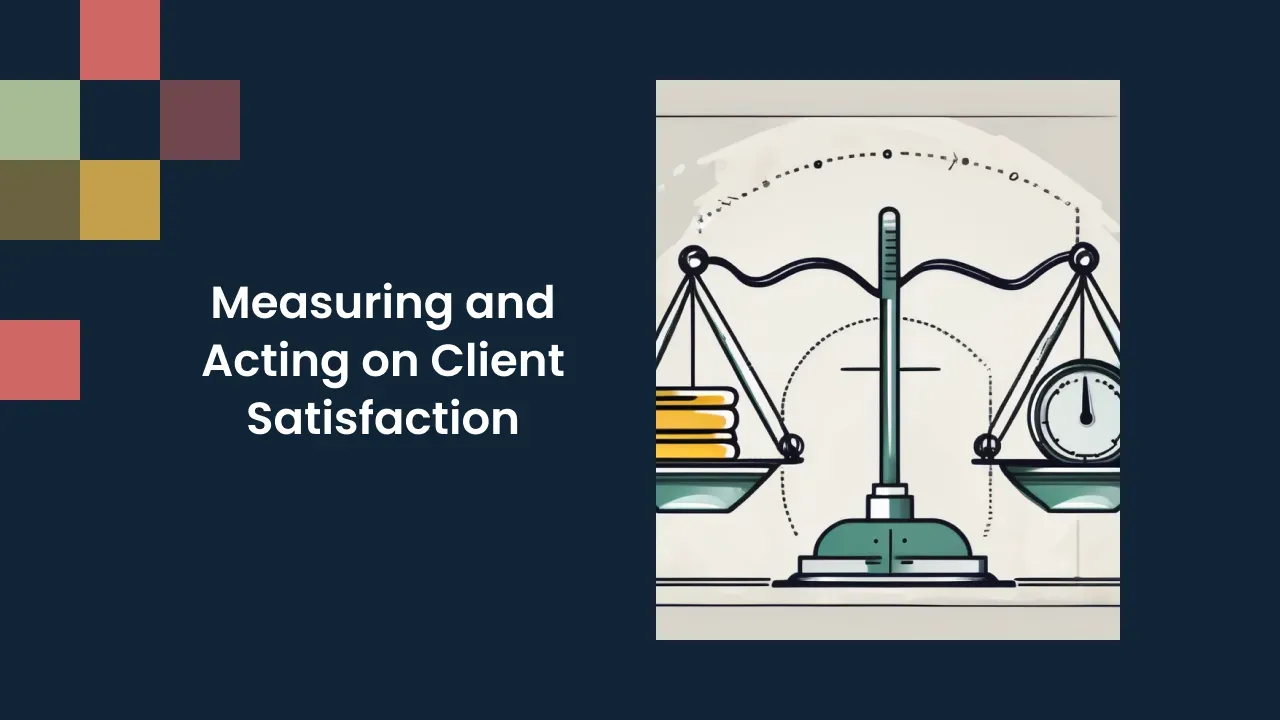Measuring and Acting on Client Satisfaction
In today's highly competitive business landscape, ensuring client satisfaction is crucial for the success and growth of any organization. Understanding the importance of client satisfaction goes beyond simply delivering products or services - it requires proactive measures to measure and act on customer feedback. This article explores the significance of client satisfaction, techniques for effectively measuring it, interpreting the data collected, and strategies for improving client satisfaction. By implementing these strategies, businesses can enhance their relationships with clients and ultimately drive long-term success.
Understanding the Importance of Client Satisfaction
Defining Client Satisfaction
Client satisfaction refers to the level of contentment or fulfillment experienced by customers after engaging with a product, service, or brand. It goes beyond mere transactional satisfaction and encapsulates the overall experience throughout the customer journey. This includes factors such as the quality of the product or service, customer support, timely delivery, ease of use, and effective communication.
Moreover, client satisfaction is not just about meeting expectations but exceeding them. When a business goes above and beyond to ensure a customer's needs are met and their experience is exceptional, it creates a lasting impression that fosters loyalty and advocacy.
The Role of Client Satisfaction in Business Success
Client satisfaction plays a pivotal role in the success of a business. Satisfied clients are more likely to become repeat customers, provide positive reviews, and refer new clients. They act as brand ambassadors, promoting the business organically. Additionally, client satisfaction has a direct impact on business growth , revenue generation, and customer loyalty. Businesses that prioritize and enhance client satisfaction inevitably gain a competitive edge in the market.
Furthermore, high levels of client satisfaction can lead to increased customer lifetime value. When customers are happy with their interactions and transactions, they are more inclined to engage with the business over the long term, resulting in higher profitability and sustainability. This underscores the importance of consistently monitoring and improving client satisfaction levels as a strategic business practice.
Techniques for Measuring Client Satisfaction
Surveys and Questionnaires
Surveys and questionnaires are effective tools for gathering quantitative and qualitative feedback from clients. By designing well-structured surveys, businesses can obtain specific insights into client preferences, experiences, and areas for improvement. These surveys can be conducted via email, online platforms, or even in-person interviews. It is essential to keep surveys concise and user-friendly, ensuring higher response rates.
Feedback Forms and Interviews
Feedback forms and interviews provide businesses with an opportunity to engage directly with clients, capturing their opinions, suggestions, and concerns. These methods offer a more personal approach, allowing for in-depth conversations that can elicit valuable qualitative data. By actively listening to client feedback, businesses can identify pain points, identify areas of improvement, and develop tailored solutions to enhance client satisfaction.
Online Reviews and Social Media Analysis
In the digital age, online reviews and social media platforms offer valuable insights into client satisfaction. Monitoring online reviews, comments, and social media conversations allows businesses to gauge sentiment and identify emerging trends. It is essential to respond promptly to any negative feedback, demonstrating a commitment to addressing concerns and finding solutions. Additionally, social media analysis tools can provide valuable data analytics to measure client satisfaction levels and identify potential areas for improvement.
Another technique for measuring client satisfaction is through customer satisfaction index (CSI) scores. CSI scores are calculated based on a variety of factors, including customer loyalty, perceived value, and overall satisfaction. By regularly assessing CSI scores, businesses can track changes in client satisfaction over time and identify areas that require improvement.
Furthermore, conducting focus groups can provide businesses with valuable insights into client satisfaction. Focus groups consist of a small group of clients who are brought together to discuss their experiences and provide feedback. This method allows for in-depth discussions and the exploration of specific topics or issues. By gathering input from a diverse group of clients, businesses can gain a deeper understanding of their needs and preferences.
Additionally, businesses can utilize customer success metrics to measure client satisfaction. These metrics include factors such as customer retention rates, upsell and cross-sell rates, and customer lifetime value. By analyzing these metrics, businesses can identify patterns and trends that indicate high levels of client satisfaction and loyalty.
Lastly, implementing a Net Promoter Score (NPS) system can provide valuable insights into client satisfaction. NPS measures the likelihood of clients recommending a business to others. By regularly surveying clients and calculating their NPS, businesses can gauge overall satisfaction and identify potential brand advocates.
Interpreting Client Satisfaction Data
Analyzing Quantitative Data
Quantitative data collected through surveys and questionnaires can be analyzed to identify trends and patterns. Utilizing data analysis tools, businesses can measure client satisfaction scores, identify areas of strength and weakness, and track changes over time. This analysis enables businesses to make data-driven decisions and prioritize actions to enhance client satisfaction effectively.
Deciphering Qualitative Feedback
Qualitative feedback collected through feedback forms, interviews, and online platforms can be equally valuable. It provides insights into the emotions, thoughts, and experiences of clients. Analyzing qualitative data can help businesses understand the underlying reasons behind specific feedback, identify recurring themes, and derive actionable recommendations. By delving into the qualitative feedback, businesses can gain deeper insights into client satisfaction and tailor their strategies accordingly.
Identifying Trends and Patterns
By combining quantitative and qualitative data analysis, businesses can identify trends and patterns in client satisfaction. This holistic approach allows for a comprehensive understanding of client needs, preferences, and pain points. Analyzing these trends helps businesses pinpoint systemic issues, predict future client expectations, and align their strategies to meet evolving demands. Regular assessment of trends and patterns ensures that businesses stay agile and proactive in improving client satisfaction.
Furthermore, when analyzing quantitative data, it is essential to consider the context in which the data was collected. Factors such as the demographics of the respondents, the timing of the survey, and any external events that may have influenced the results can all impact the interpretation of the data. For example, if a survey was conducted during a period of economic downturn, it is important to take into account that the overall satisfaction scores may be lower due to external factors beyond the control of the business.
In addition to analyzing qualitative feedback, businesses can also benefit from conducting sentiment analysis. This involves using natural language processing techniques to determine the sentiment expressed in customer feedback. By categorizing feedback as positive, negative, or neutral, businesses can gain a deeper understanding of the overall sentiment of their clients. This information can then be used to identify areas of improvement and develop targeted strategies to address any negative sentiment.
Strategies for Improving Client Satisfaction
Enhancing Product or Service Quality
One of the most effective strategies for improving client satisfaction is by enhancing the quality of products or services. By investing in research and development, businesses can innovate and offer superior solutions that exceed client expectations. Regular performance evaluations, feedback loops, and quality assurance processes help identify areas for improvement and drive continuous enhancement.
Improving Customer Service
Customer service is a critical component of client satisfaction. By providing prompt and personalized support, businesses can ensure that clients receive timely assistance and have their concerns addressed effectively. Implementing efficient customer service channels, training customer support teams, and delivering exceptional customer experiences can significantly enhance client satisfaction and loyalty.
Personalizing Client Experiences
Personalization is a powerful technique for improving client satisfaction. By understanding individual client needs and preferences, businesses can tailor their offerings and communication to create a more personalized experience. This can include customized recommendations, exclusive offers, and personalized interactions that demonstrate a deep understanding of each client's unique requirements. Personalization fosters a sense of importance and connection , leading to higher client satisfaction levels.
However, enhancing client satisfaction goes beyond these strategies. It requires a comprehensive approach that takes into account various aspects of the client-business relationship. For instance, businesses can focus on building strong relationships with their clients by establishing regular communication channels and providing ongoing support. This can involve sending newsletters, organizing client appreciation events, or even conducting client satisfaction surveys to gather valuable feedback.
Moreover, businesses can also invest in technology solutions that streamline client interactions and improve overall satisfaction. For example, implementing a user-friendly client portal where clients can access their accounts, track their orders, and communicate with the business can enhance convenience and efficiency. Additionally, utilizing data analytics tools to analyze client behavior and preferences can help businesses identify patterns and make informed decisions to further enhance client satisfaction.
In conclusion, client satisfaction is a vital aspect of business success and growth. By measuring and acting on client satisfaction, businesses can not only improve customer retention but also foster long-term customer loyalty. Utilizing techniques such as surveys, feedback forms, and social media analysis allows businesses to gather valuable data for analysis. Interpreting this data enables businesses to uncover key insights, identify trends, and drive strategic actions. By implementing strategies to enhance product or service quality, improving customer service, personalizing client experiences, and adopting a comprehensive approach, businesses can ensure higher levels of client satisfaction, leading to sustainable business growth in today's competitive market.
More from Pixifi











